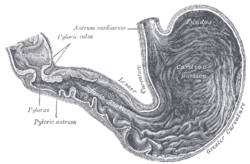Pylorus
| Pylorus | |
|---|---|

Inside of the stomach (pylorus labeled at center left)
|
|
| Details | |
| Identifiers | |
| Latin | Pylorus |
| Dorlands /Elsevier |
v_02/12844554 |
| TA | A05.5.01.014 |
| FMA | 14581 |
|
Anatomical terminology
[]
|
|
The pylorus (/paɪˈlɔərəs/ or /pᵻˈloʊrəs/), or pyloric part, connects the stomach to the duodenum. The pylorus is considered as having two parts, the pyloric antrum (opening to the body of the stomach) and the pyloric canal (opening to the duodenum). The pyloric canal ends as the pyloric orifice, which marks the junction between the stomach and the duodenum. The orifice is surrounded by a sphincter, a band of muscle, called the pyloric sphincter. The word pylorus comes from Greek πυλωρός, via Latin. The word pylorus in Greek means "gatekeeper", related to "gate" (Greek: pyle) and is thus linguistically related to the word "pylon".
The pylorus is the furthest part of the stomach that connects to the duodenum. It is divided into two parts, the antrum, which connects to the body of the stomach, and the pyloric canal, which connects to the duodenum.
The pyloric antrum is the initial portion of the pylorus. It is near the bottom of the stomach, proximal to the pyloric sphincter, which separates the stomach and the duodenum. It may temporarily become partially or completely shut off from the remainder of the stomach during digestion by peristaltic contraction of the prepyloric sphincter; it is demarcated, sometimes, from the pyloric canal by a slight groove.
...
Wikipedia
